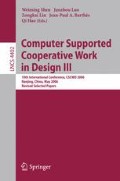Abstract
Dimensional error is one of the most important product quality characteristics during slender bar turning operations. In this study, artificial neural network was employed to investigate the dimensional errors during slender bar turning process. A systematic method based on neural network modeling technique and statistical tool was designed to select the input parameters of the monitoring model. The average effect of each candidate machining factor and sensed information on the modeling performance was determined. Then, the monitoring system was developed to perform the in-process prediction of dimensional errors. Experimental results showed that the proposed system had the ability to monitor efficiently dimensional errors within the range that it had been trained.
Access this chapter
Tax calculation will be finalised at checkout
Purchases are for personal use only
Preview
Unable to display preview. Download preview PDF.
References
Yang, S., Yuan, J., Ni, J.: Real-time cutting force induced error compensation on a turning center. International Journal of Machine Tools and Manufacture 37(11), 1597–1610 (1997)
Mayer, J.R.R., Phan, A.-V., Cloutier, G.: Prediction of diameter errors in bar turning: a computationally effective model. Applied Mathematical Modeling 24, 943–956 (2000)
Gi-Bum, J., Dong, H.K., Dong, Y.J.: Real time monitoring and diagnosis system development in turning through measuring a roundness error based on three-point method. International Journal of Machine Tools and Manufacture 45, 1494–1503 (2005)
Shunmugam, M.S.: On assessment of geometric errors. International Journal of Production Research 24(2), 413–425 (1986)
Zhang, H.C., Huang, S.H.: Artificial neural networks in manufacturing-a state of the art survey. International Journal of Production Research 33(3), 705–728 (1995)
Suneel, T.S., Pande, S.S., Date, P.P.: A technical note on integrated product quality model using artificial neural networks. Journal of Materials Processing Technology 121, 77–86 (2002)
Özel, T., Karpat, Y.: Predictive modeling of surface roughness and tool wear in hard turning using regression and neural networks. International Journal of Machine Tools and Manufacture 45, 467–479 (2005)
Ezugwu, E.O., Fadare, D.A., Bonney, J.: Modeling the correlation between cutting and process parameters in high-speed machining of Inconel 718 alloy using an artificial neural network. International Journal of Machine Tools and Manufacture 45, 1375–1385 (2005)
Azouzi, R., Guillot, M.: On-line prediction of surface finish and dimensional deviation in turning using neural network based sensor fusion. International Journal of Machine Tools and Manufacture 37(9), 1201–1217 (1997)
Suneel, T.S., Pande, S.S.: Intelligent tool path correction for improving profile accuracy in CNC turning. International Journal of Production Research 38(14), 3181–3202 (2000)
Li, X.: Real-time prediction of workpiece errors for a CNC turning centre, Part 4. Cutting-force-induced errors. International Journal of Advanced Manufacturing Technology 17, 665–669 (2001)
Risbood, K.A., Dixit, U.S., Sahasrabudhe, A.D.: Prediction of surface roughness and dimensional deviation by measuring cutting forces and vibrations in turning process. Journal of Materials Processing Technology 132, 203–214 (2003)
Demuth, H., Beale, M.: Neural Network Toolbox User’s Guide. Version 4. The Mathworks Inc. (2000)
Foresee, F.D., Hagan, M.T.: Gauss-Newton approximation to Bayesian regularization. In: Proceedings of the 1997 International Joint Conference on Neural Networks, pp. 1930–1935 (1997)
Mayer, J.R.R., Phan, A.V., Cloutier, G.: Prediction of diameter errors in bar turning: a computationally effective model. Applied Mathematical Modeling 24, 943–956 (2000)
Author information
Authors and Affiliations
Editor information
Rights and permissions
Copyright information
© 2007 Springer-Verlag Berlin Heidelberg
About this paper
Cite this paper
Han, R., Cui, B., Guo, J. (2007). In-Process Monitoring of Dimensional Errors in Turning Slender Bar Using Artificial Neural Networks. In: Shen, W., Luo, J., Lin, Z., Barthès, JP.A., Hao, Q. (eds) Computer Supported Cooperative Work in Design III. CSCWD 2006. Lecture Notes in Computer Science, vol 4402. Springer, Berlin, Heidelberg. https://doi.org/10.1007/978-3-540-72863-4_29
Download citation
DOI: https://doi.org/10.1007/978-3-540-72863-4_29
Publisher Name: Springer, Berlin, Heidelberg
Print ISBN: 978-3-540-72862-7
Online ISBN: 978-3-540-72863-4
eBook Packages: Computer ScienceComputer Science (R0)

